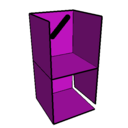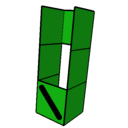[previous configuration]
[up to this 3D shape]
[next configuration]
― Configuration code: RRmDmUmRmLUmDm

- Start from

- Close it into a 2x3 rectangle (2 rows, 3 columns) with two stacks of two tiles in
opposite corners. Of the remaining four tiles two are connected to
the lower tiles of each stack (first floor)
and two are connected to the upper tiles of each stack (second floor)
- Note: There are two enantiomorph versions of the starting shape, the following instructions
refer to the enantiomorph version shown in the figure above.
- Position the 2x3 rectangle such that the two stacks are in the north-west and
south-east corners, the south-west tile is backslash and on the
first floor, the north-east tile is backslash and on the second floor.
- Open again in 3D with the following hinging:
- The north-west stack about the vertical (west) side.
Call it vh1: vertical hinge n. 1
- The south-east stack about the horizontal (south) side.
Call it hh3
Further denote by
- vh2, resp. vh3: vertical hinge between west and central tiles (north, resp. south)
- vh4, resp, vh5: vertical hinge between central and east tiles (north, resp. south)
- hh1: horizontal hinge between north-west and south-west tiles
- hh2: horizontal hinge between north-east and south-east tiles
The opening must be done such that:
- vh1 is completely reverted 360 degrees
- hh3 opened 90 degrees
- vh2 mountain fold 90 degrees
- vh4 mountain fold 90 degrees
- hh2 remains flat
- vh5 valley fold 90 degrees
- vh3 valley fold 90 degrees
- hh1 mountain fold 90 degrees
To this end it might be useful to first perform the complete reversal of vh1
together with 180 mountain (resp. valley) fold of vh2 and vh3
- Turn a flap tile 180 degrees into the final shape
